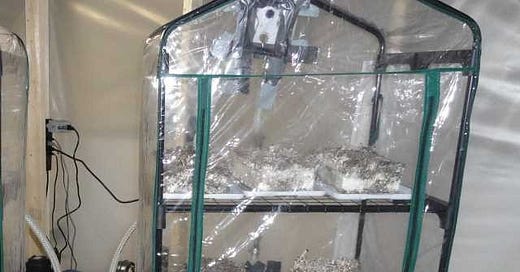Building and Setting Up a DIY Mushroom Fruiting Tent
Cultivating mushrooms indoors is no easy task. It can be both frustrating yet rewarding. This article will focus on the particulars of this tent build and setup, the methods and how they were used to set the right conditions for mushroom cultivation. The purpose of this build is to build something that is not too expensive and not too complicated so that anyone can grow mushrooms indoors. One of the main goals was to automate some of the tasks with the use of home building and methods of automation that can simplify the complexity of a fruiting tent, or a complex/automated fruiting tent.
Continuous Air Exchange
A continuous air exchange system was one of the basic design features for the fruiting tent. Instead of relying on normal fans or control devices for the air, the designer came up with a system that utilized a tube to connect to fresh air from the surrounding environment. This provided a steady stream of fresh air for the tent while maximizing air quality for mushroom cultivation without any additional equipment.
Humidity Control
The correct humidity for mushroom growing is essential. Therefore, the creator implemented a humidifier in the system to help keep consistent humidity levels of 70% on top and 95% on the bottom. The use of the humidifier, which runs continuously (24/7) enabled the system to remove the labor of checking humidity levels and adjusting, thus providing fungi with a constant environment to grow mushrooms.
Temperature Regulation
Alongside humidity management, an appropriate temperature is also critical for mushroom growth. To facilitate this, the creator utilized temperature-controlled tents to maintain a consistent temperature of 21 degrees Celsius. This temperature was optimal for grain spawn and grow bag colonization, which expedited the overall mushrooming process.
Monitoring and Observation
A notable characteristic of the fruiting tent was the use of DIY glass windows to view inside the tent and monitor the environment without opening the ichthusing sal-ear. This allowed the builder to look at CO2 levels, humidity levels, and the mushroom growth without opening doors in which could disrupt the environment.
Fruiting Chamber Configuration
Inside the fruiting tent, the creator made a deliberate plan for positioning the grow bags and other cultivating materials. By placing items at varying heights, the creator was able to create a range of different humidities to suit the mushrooms through their different stages of growth.
Additional Enhancements
To improve the setup of the fruiting tent, the creator added more features like filtration systems to help ensure air quality and contaminants do not accumulate. Additionally, more fans and tubes were added to properly remove CO2 and mushroom spores from the air to provide a clean and healthy cultivation space.
In summary, creating and assembling a DIY mushroom fruiting tent necessitates careful consideration and planning. By using some creative techniques and DIY strategies, the creator was able to generate an inexpensive and efficient system for growing mushrooms at home. The setup accounted for continuous air exchange and humidity control and all issues were addressed in the design to ensure the ideal conditions to grow mushrooms. Regardless of whether you are a beginner or experienced cultivator, the techniques described can be a useful guide to constructing your own mushroom fruiting tent and experiencing the fun of home cultivation.




